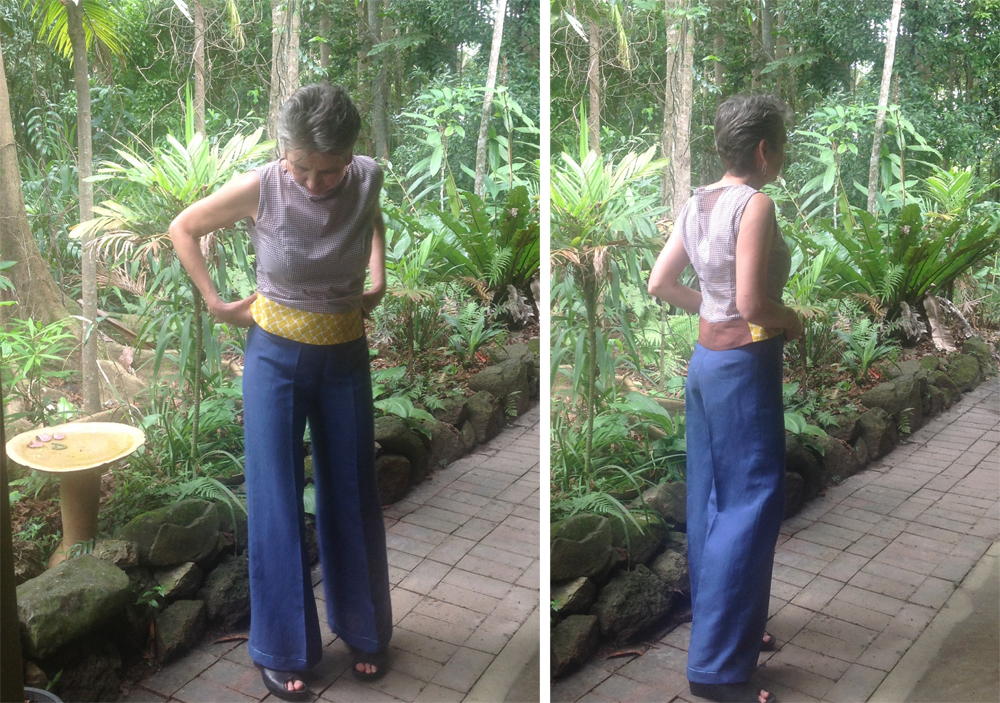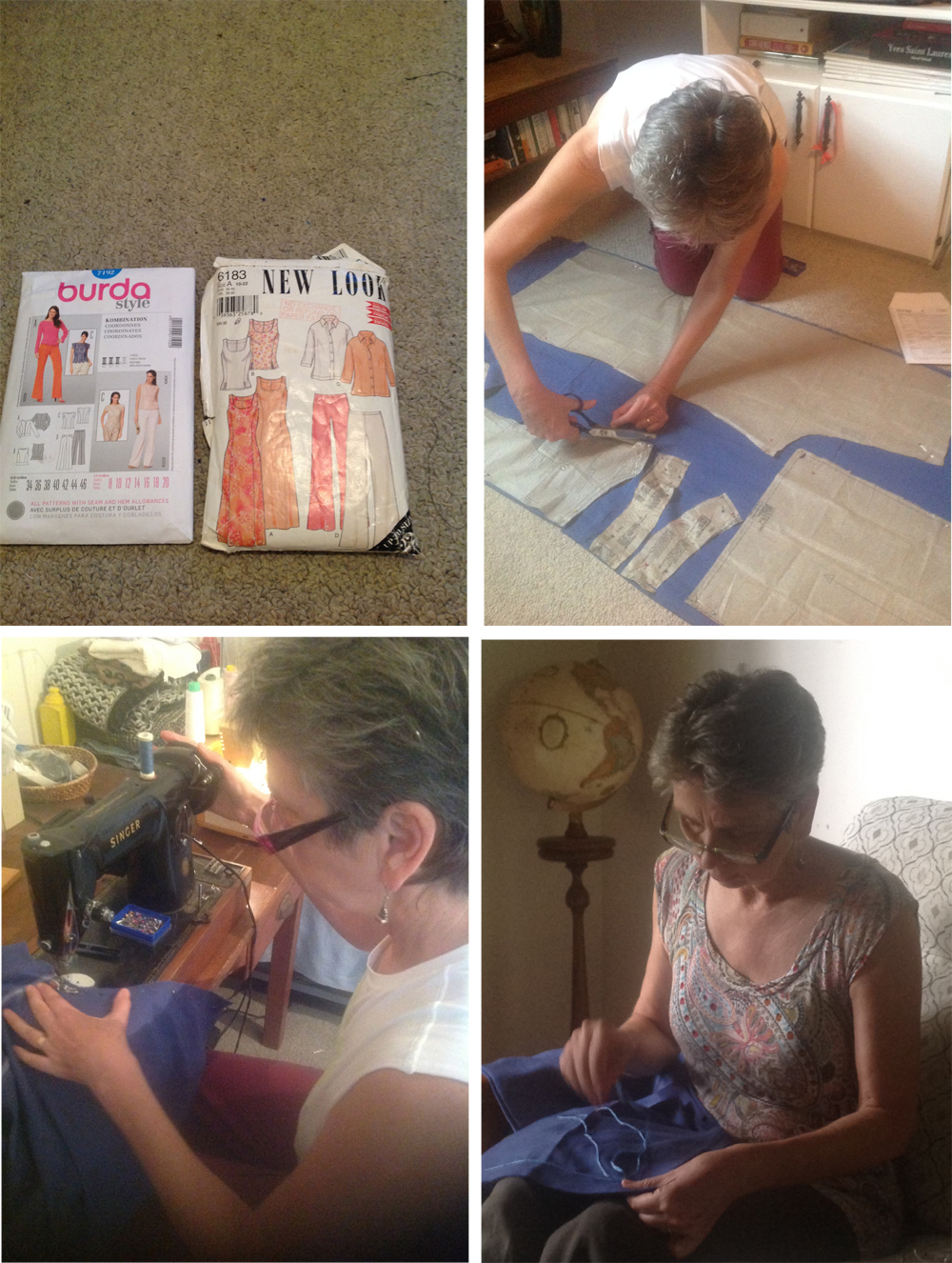Handmade skills give Frances Leske enormous self-confidence, self-satisfaction and pleasure. These skills greatly enhance her wellbeing, even though they may originate from a background of survival and living within your means.

Frances Leske used fabric gifted from her mother to create wide-leg pants and a top for The Slow Clothing Project.
“Making my own clothing brings me joy – the wonderful feeling of achievement and the positive comments made by people in the street. I love to sew and create garments for myself which are unique, handmade with care and attention. It brings me such joy,” she said.
Frances – who lives at Mullumbimby in New South Wales and runs a Meals on Wheels organisation – bought her first sewing machine at 19, when her work colleagues won $38 each on Tattslotto 2nd division and she chose to spend it on a simple Singer machine. She and her sisters learned to sew as teenagers, taught by her mother on an Elna her Mum still owns. “My mother also taught me to spin and weave, and she wove beautiful fabrics from fleece she spun and dyed, selling them (cheaply) to give the family additional income,” Frances said.
“I’ve been making clothes for myself for more than 40 years and enjoy wearing handmade garments and well-worn clothing. I’m now 58 and still love to sew. Over time, I have sewn clothing for my daughters – dresses and pants, including school uniforms. I’ve sewn shirts for my husband and myriad clothing for myself including blouses, dresses, shirts, pants, shorts and skirts. I’d estimated that in my current wardrobe about 45% is recycled, 30% made by me and 25% manufactured. Amongst all these 3 areas, 10% is restyled. The clothing made by me includes some of my hand knitted garments.”
Frances sees The Slow Clothing Project as a wonderful opportunity to sew a garment with imagination, flair and simply pleasure. “The project really excites me because it brings alive those wonderful reclaimed fabrics and clothing which so often become stuffing for pillows, given to charity shops, torn into rags to wash the car and sold on EBay.”
She has chosen to make a pair of wide-legged pants made from a piece of vintage fabric (gifted by her mother, left over from her sewing days) which Frances teamed a simple blouse.
“It is a fine linen, soft and beautiful to sew. I used a New Look pattern, which has been a staple pattern of mine for about 20 years. I only had one glitch – a small hole in the fabric on the back, which l have since darned. The top is made from a collection of fabric pieces from my mother as well. A mix of cotton and linen. I used a Burda pattern which I have used many times. No glitches with this piece. A real pleasure to sew, using a mix of fabrics.”
 Frances said the concept of slow appears in many aspects of her home life. “I love knitting an article, watching it grow and evolve into a garment or accessory. Having utensils and tools around my home which we have owned for years, looked after them and they continue to give us great service. I recently had my Bamix stop working. I bought it in the ‘80s after saving the $80 it cost and it has given us long and wonderful service. My sewing machine is an original Singer, Model 201K, which my husband picked up for me in the ‘80s. It only sews forward and backwards, is solid and reliable. I have it serviced every couple of years and it is wonderful to sew with. I use my mother’s overlocker or finish off edges with hand sewing. I avoid button holes!”
Frances said the concept of slow appears in many aspects of her home life. “I love knitting an article, watching it grow and evolve into a garment or accessory. Having utensils and tools around my home which we have owned for years, looked after them and they continue to give us great service. I recently had my Bamix stop working. I bought it in the ‘80s after saving the $80 it cost and it has given us long and wonderful service. My sewing machine is an original Singer, Model 201K, which my husband picked up for me in the ‘80s. It only sews forward and backwards, is solid and reliable. I have it serviced every couple of years and it is wonderful to sew with. I use my mother’s overlocker or finish off edges with hand sewing. I avoid button holes!”
“I have found a sense of resourcefulness in the items I own. I enjoy the part they play in my life, the good service they give, providing me with satisfaction and happiness. I am cheap to run!
“Handmade skills come from a background of survival and living within your means. They give enormous self-confidence, self-satisfaction and pleasure, greatly enhancing wellbeing. If one relied on these skills for a living, the income would be limited as the garment or other is often priced at the costs of materials, with little of the time and effort involved in the making being costed into the selling price.
“l dislike poorly made, synthetic, mass-produced clothing – it is tasteless, lacks finesse, is cheap, nasty and supports companies driven by profit who exploit people desperate to feed their families and keep a roof over their heads.
“By contrast, a handmade garment gives oneself self-pride in making, then wearing it. It’s a fabulous feeling!”
So what advice does Frances have for those interested in sewing? “Start small, even have some lessons and seek advice. Patience is needed and I have heard this used as an excuse not to sew; yet if you develop a step at a time and have a good back-up person for advice, support and encouragement, then sewing your own clothing is something anyone can do.”
Thank you for sharing your story Frances … we understand your sense of joy in the making J